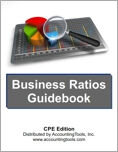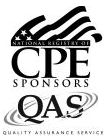Business Ratios Guidebook (CPE Course)
CPE Credit: 16 hours
Course Type: Downloaded PDF materials with online test
Price (with PDF Textbook): $110
Course Description
Today's financial executive needs a way to assess the financial performance and financial position of business organizations. The Business Ratios Guidebook provides one of the best ways to do so by describing more than 200 ratios and other measurements. When applied to an organization's financial statements, these ratios can clarify its results, liquidity, and cash flows. The measurement areas covered include performance, return on investment, share performance and constraints. Examples of the functional areas also covered include cash management, credit and collections, customer service, human resources, production, and sales. In short, this course is the ultimate desk reference for ratio analysis.
Author: Steven Bragg
Course Number: FN1011
Table of Contents
Chapter 1. Overview of Measurements
Chapter 2. Performance Measurements
Chapter 3. Liquidity Measurements
Chapter 4. Cash Flow Measurements
Chapter 5. Return on Investment Measurements
Chapter 6. Share Performance Measurements
Chapter 7. Growth Measurements
Chapter 8. Constraint and Throughput Measurements
Chapter 9. Cash Management Measurements
Chapter 10. Credit and Collection Measurements
Chapter 11. Customer Service Measurements
Chapter 12. Facility Measurements
Chapter 13. Financing Measurements
Chapter 14. Fixed Asset Measurements
Chapter 15. Human Resources Measurements
Chapter 16. Inventory Measurements
Chapter 17. Payroll Measurements
Chapter 18. Pricing Measurements
Chapter 19. Production Measurements
Chapter 20. Product Design Measurements
Chapter 21. Purchasing Measurements
Chapter 22. Payables Measurements
Chapter 23. Sales and Marketing Measurements
Learning Objectives
Recognize the circumstances under which certain measurements should be used.
Specify the contents of the various performance measurements, and the factors they are intended to compare.
Recognize the components of the cash conversion cycle and the ratios derived from it.
Identify the contents of the free cash flow concept and the measurements related to cash flow.
Cite the situations in which return on investment measurements can be used, and the factors they are intended to compare.
Recognize the measurements that can be used to reduce the number of unused fixed assets.
Identify the parties using share performance measurements, and the future conditions that these measurements can indicate.
Identify the adjustment factor used for deflated growth measures, and the situations in which these measurements are used.
Specify the key factors to be monitored in a system of constraint management.
Recognize the contents of the cash management measurements, and when their results should trigger an investigation.
Identify the behaviors on which credit and collection measurements are intended to focus attention.
Recognize the conditions that can be uncovered through use of customer service measurements.
Identify the situations in which certain facility-related measurements should be used.
Cite the measurements used to examine the ability to pay, and the situations in which these measurements can be used.
Identify the situations in which fixed asset measurements can be most gainfully employed, and when they are of reduced value.
Identify the types of behaviors that certain human resources measurements can be used to track.
Recognize the effects of using certain inventory measurements.
Specify the effects that can skew the outcomes of payroll-related measurements.
Cite the effects of price elasticity on profitability, and how elasticity can be altered.
Recognize the measurements that can track the performance level of a production process and the usage of inventory.
Specify the measurements that should be used to focus attention on the development of products.
Identify the purchasing measurements most useful for monitoring progress toward supplier certification and reduction, as well as the use of procurement cards.
Cite the situations in which certain payables measurements can yield incorrect or skewed results.
Recognize the measurements used to monitor different types of sales and marketing behaviors.
Level: Overview
Instructional Method: QAS Self-Study
NASBA Category: Finance
Prerequisites: None
Advance Preparation: None
Latest Review Date: October 2023
Program Registration Requirements: Click on "Purchase Course" near the top of this page to pay for and access the course. You will then be able to download the course as a PDF file, then take an on-line examination, and then download a certificate of completion if you pass the examination.
Program Refund Policy: For more information regarding administrative policies concerning complaints, refunds, and other matters, see our policies page.
AccountingTools, Inc. is registered with the National Association of State Boards of Accountancy (NASBA) as a sponsor of continuing professional education on the National Registry of CPE Sponsors. State boards of accountancy have the final authority on the acceptance of individual courses for CPE credit. Complaints regarding registered sponsors may be submitted to the National Registry of CPE Sponsors through its website: www.nasbaregistry.org.
The NASBA sponsor identification number for Accountingtools, Inc. is 115881.
AccountingTools is an IRS Approved Continuing Education Provider. We are compliant with the requirements for continuing education providers (as described in sections 10.6 and 10.9 of the Department of Treasury’s Circular No. 230 and in other IRS guidance, forms, and instructions). Our IRS Approved Continuing Education Provider number is 72821.


